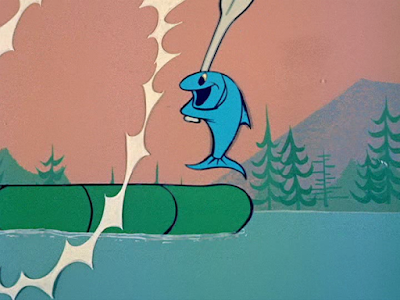The original Yogi Bear wasn’t quite the Yogi Bear we all know today.
After Warren Foster arrived at Hanna-Barbera in April 1959 and took over writing the Yogi cartoons, a decision was made to put Yogi in a consistent setting with a consistent cast. So the bear was given a home in Jellystone Park, Boo Boo was made a permanent sidekick and Ranger Smith was added to give Yogi someone to conflict with. This template made for stronger story potential and, evidently, resulted in the character becoming more popular, and certainly more memorable.
But I still really like the pre-Foster Yogi that appeared on the first season of the Huckleberry Hound Show, and mourn his passing. Yogi was sometimes in Jellystone, other times in what appears to have been some generic woods. Several different rangers appeared on occasion. Boo Boo wasn’t always there. (As a side note, there was an awful lot less dialogue, even though Charlie Shows had been hired specifically to write words. I suppose it was natural, considering Joe Barbera and Bill Hanna had worked with silent characters for 17 years).
The first-season Yogi also occasionally employed the spot-gag format, which I really liked. Many of the theatrical studios had tried it, both in live-action and animated shorts. A narrator gives a line of patter on a particular subject, setting up a sight-gag on the screen. Then it’s on to the next gag.
There’s one problem with sight-gag cartoons—you have to rely on the artwork, and TV animation budgets are such that dialogue gags are wayyyy cheaper. Still, the Hanna-Barbera cartoons in that 1958-59 season carried it off.
If I had to pick a favourite spot-gagger, at least right this moment, it would have to be The Stout Trout, where narrator Don Messick accompanied Yogi Bear’s continual failed attempts to catch a fish in a lake. Much of the cartoon is animated by Carlo Vinci. Below are some frames of Yogi swatting his arm into the lake, and then after the fish sprays his face with water. You can see Yogi’s expressions. They’re solidly drawn. Sure, they’re not over-the-top reactions like you’d see in a Tex Avery or Bob Clampett theatrical, but no one was animating like that by the late 1950s. Carlo had Yogi glance toward the TV viewers near the start of some pieces of the narration to include us, and to avoid the monotony of a long held drawing.
![]()
![]()
![]()
![]()
Carlo also finds interesting things to do with hands, er, paws.
![]()
![]()
![]()
And here’s something else Hanna-Barbera eventually avoided. Perspective animation.
![]()
![]()
![]()
![]()
I realise Foster’s Jellystone structure propelled Yogi into greater success that lasts even to today and resulted in some funny cartoons, but, and I guess I’m in the minority, I miss the spot-gag format and wish Hanna-Barbera would have carried on using it with its syndicated characters.
After Warren Foster arrived at Hanna-Barbera in April 1959 and took over writing the Yogi cartoons, a decision was made to put Yogi in a consistent setting with a consistent cast. So the bear was given a home in Jellystone Park, Boo Boo was made a permanent sidekick and Ranger Smith was added to give Yogi someone to conflict with. This template made for stronger story potential and, evidently, resulted in the character becoming more popular, and certainly more memorable.
But I still really like the pre-Foster Yogi that appeared on the first season of the Huckleberry Hound Show, and mourn his passing. Yogi was sometimes in Jellystone, other times in what appears to have been some generic woods. Several different rangers appeared on occasion. Boo Boo wasn’t always there. (As a side note, there was an awful lot less dialogue, even though Charlie Shows had been hired specifically to write words. I suppose it was natural, considering Joe Barbera and Bill Hanna had worked with silent characters for 17 years).
The first-season Yogi also occasionally employed the spot-gag format, which I really liked. Many of the theatrical studios had tried it, both in live-action and animated shorts. A narrator gives a line of patter on a particular subject, setting up a sight-gag on the screen. Then it’s on to the next gag.
There’s one problem with sight-gag cartoons—you have to rely on the artwork, and TV animation budgets are such that dialogue gags are wayyyy cheaper. Still, the Hanna-Barbera cartoons in that 1958-59 season carried it off.
If I had to pick a favourite spot-gagger, at least right this moment, it would have to be The Stout Trout, where narrator Don Messick accompanied Yogi Bear’s continual failed attempts to catch a fish in a lake. Much of the cartoon is animated by Carlo Vinci. Below are some frames of Yogi swatting his arm into the lake, and then after the fish sprays his face with water. You can see Yogi’s expressions. They’re solidly drawn. Sure, they’re not over-the-top reactions like you’d see in a Tex Avery or Bob Clampett theatrical, but no one was animating like that by the late 1950s. Carlo had Yogi glance toward the TV viewers near the start of some pieces of the narration to include us, and to avoid the monotony of a long held drawing.




Carlo also finds interesting things to do with hands, er, paws.



And here’s something else Hanna-Barbera eventually avoided. Perspective animation.




I realise Foster’s Jellystone structure propelled Yogi into greater success that lasts even to today and resulted in some funny cartoons, but, and I guess I’m in the minority, I miss the spot-gag format and wish Hanna-Barbera would have carried on using it with its syndicated characters.